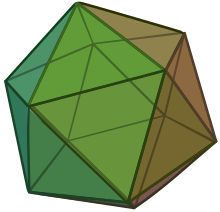
Back Ikosaëder Afrikaans عشروني سطوح Arabic İkosaedr Azerbaijani Икосаедър Bulgarian Icosaedre Catalan Dvacetistěn Czech Ikosaeder Danish Ikosaeder German Εικοσάεδρο Greek Dudekedro Esperanto


In geometry, an icosahedron (/ˌaɪkɒsəˈhiːdrən, -kə-, -koʊ-/ or /aɪˌkɒsəˈhiːdrən/[1]) is a polyhedron with 20 faces. The name comes from Ancient Greek εἴκοσι (eíkosi) 'twenty' and ἕδρα (hédra) 'seat'. The plural can be either "icosahedra" (/-drə/) or "icosahedrons".
There are infinitely many non-similar shapes of icosahedra, some of them being more symmetrical than others. The best known is the (convex, non-stellated) regular icosahedron—one of the Platonic solids—whose faces are 20 equilateral triangles.
- ^ Jones, Daniel (2003) [1917], Peter Roach; James Hartmann; Jane Setter (eds.), English Pronouncing Dictionary, Cambridge: Cambridge University Press, ISBN 3-12-539683-2